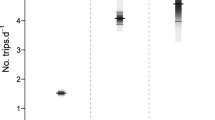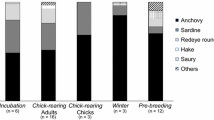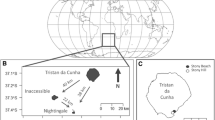Abstract
Interpreting the impact of environmental change on food webs requires a clear understanding of predator–prey interactions. Such knowledge is often lacking in the marine environment where the foraging behaviour and prey requirements of some of the major top-predators remains mysterious. For example, very little is known about the underwater foraging behaviour of the little auk, the most numerous seabird in the North Atlantic. In 2004, we used time–depth-recorders at two breeding colonies in East Greenland to examine the diving behaviour of this small, planktivorous seabird during the chick-rearing period. Due to technical difficulties data were only collected for four individuals, but recordings showed that birds dive up to 240 times a day to maximum depths of 27 m (average 10 m), with maximum dive durations of 90 s (average 52 s). In addition, we collected the chick meals from 35 individuals, which were dominated by Calanus copepods (95%), and also determined the field metabolic rates (FMR) of 14 individuals using the doubly labelled water technique, which averaged 609.9 kJ day−1. We integrated information on diving duration with chick diet and FMR to estimate the prey requirements and underwater capture rates of little auks using a Monte Carlo simulation. Chick-rearing little auks needed to catch about 59,800 copepods day−1, which is equivalent to about six copepods caught per second spent underwater. These astonishing results strongly suggest that little auks are, at least partly, filter-feeding, and underline the importance of highly productive, cool marine areas that harbour dense patches of large, energy-rich copepods.



Similar content being viewed by others
References
Ackerman JT, Adams J, Takekawa JY, Carter HR, Whitworth DL, Newman SH, Golightly RT, Orthmeyer DL (2004) Effects of radiotransmitters on the reproductive performance of Cassin’s auklets. Wildlife Soc Bull 43(4):1–13
Ainley DG, Sydeman WJ, Norton J (1995) Upper trophic level predators indicate interannual negative and positive anomalies in the California current food web. Mar Ecol Prog Ser 118:69–79
Arctic Climate Impact Assessment (ACIA) (2004) Impacts of a warming Arctic: Arctic Climate Impact Assessment. Cambridge University Press, Cambridge
Båmstedt U (1986) Chemical composition and energy content. In: Corner EDS, O’Hara SCM (eds) The biological chemistry of marine copepods. Clarendon, Oxford, pp 1–58
Båmstedt U, Eilertsen H-C, Tande K, Slagstad D, Skjoldal HR (1991) Copepod grazing potential and its potential impact on the phytoplankton development in the Barents Sea. Polar Res 10:339–353
Beaugrand G, Reid PC, Ibañez F, Lindley JA (2002a) Diversity of calanoid copepods in the North Atlantic and adjacent seas: species associations and biogeography. Mar Ecol Prog Ser 232:179–195
Beaugrand G, Reid PC, Ibañez F, Lindley JA, Edwards M (2002b) Reorganization of North Atlantic marine copepod biodiversity and climate. Science 296:1692–1694
Benvenuti S, Dall’Antonia L, Lyngs P (2001) Foraging behaviour and time allocation of chick-rearing razorbills Alca torda at Graesholmen, central Baltic Sea. Ibis 143:402–412
Berestovskii EG, Anisimova NA, Denisenko CG, Luppova EN, Savinov VM, Timofeev CF (1989) Relationships between size and body mass of some invertebrates and fish of the North-East Atlantic. Academy of Sciences of the USSR. Murman Marine Biological Institute, Apatity, pp 1–24
Błachowiak-Samołyk K, Kwaśniewski S, Richardson K, Dmoch K, Hansen E, Hop H, Falk-Petersen S, Mouritsen LT (2006) Arctic zooplankton do not perform diel vertical migration (DVM) during periods of midnight sun. Mar Ecol Prog Ser 308:101–116
Blanc S, Geloen A, Pachiaudi C, Gharib C, Normand S (2000) Validation of the doubly labeled water technique in rats during isolation and simulated microgravity. Am J Physiol Regul Integr Comp Physiol 279:R1964–R1979
Bradstreet MSW (1982) Pelagic feeding ecology of dovekies Alle alle in Lancaster Sound and Western Baffin Bay. Arctic 35:126–140
Bradstreet MSW, Brown RGB (1985) Feeding ecology of the Atlantic Alcidae. In: Nettleship DN, Birkhead TR (eds) The Atlantic Alcidae. Academic Press, London-Toronto, pp 264–313
Bryden HL, Longworth HR, Cunningham SA (2005) Slowing of the Atlantic meridional overturning circulation at 25°N. Nature 438:655–657
Burger AE (1991) Maximum diving depths and underwater foraging in alcids and penguins. Can Wildl Occasion Paper 68:9–15
Cherel Y, Weimerskirch H (1995) Seabirds as indicators of marine resources: black-browed albatrosses feeding on ommastrephid squids in Kerguelen waters. Mar Ecol Prog Ser 129:295–300
Clark A, Harris CM (2003) Polar marine ecosystems: major threats and future change. Environ Conserv 30:1–25
Clark PU, Pisias NG, Stocker TF, Weaver AJ (2002) The role of the thermohaline circulation in abrupt climate change. Nature 415:863–869
Coward WA (1990) Calculation of pool sizes and flux rates. In: Prentice AM (ed) The doubly labelled water method: technical recommendations for use in humans. Report of an IDECG Expert Working Group, AERA, Vienna, Austria, pp 48–68
Croll DA, Gaston AJ, Burger AE, Konnoff D (1992) Foraging behavior and physiological adaptation for diving in thick-billed murres. Ecology 73:344–356
Dall’Antonia L, Gudmundsson GA, Benvenuti S (2001) Time allocation and foraging pattern of chick-rearing razorbills in northwest Iceland. Condor 103:469–480
Digby PSB (1961) The vertical migration and movements of marine plankton under midnight-sun conditions in Spitsbergen. J Anim Ecol 30:9–25
Evans PGH (1981) Ecology and behaviour of the little auk Alle alle in West Greenland. Ibis 123:1–18
Falk K, Pedersen CE, Kampp K (2000) Measurements of diving depths in dovekies (Alle alle). Auk 117:522–524
Frederiksen M, Edwards M, Richardson AJ, Halliday C, Wanless S (2006) From plankton to top-predators: bottom-up control of a marine food web across four trophic levels. J Anim Ecol 75:1259–1268
Furness RW, Campuysen CJ (1997) Seabirds as monitors of the marine environment. ICES J Mar Sci 54:726–737
Gabrielsen GW, Taylor JRE, Konarzewski M, Mehlum F (1991) Field and laboratory metabolism and thermoregulation in dovekies (Alle alle). Auk 108:71–78
Harding AMA, Van Pelt TI, Lifjeld JT, Mehlum F (2004) Sex differences in little auk Alle alle parental care: transition from biparental to paternal-only care. Ibis 146:642–651
Harding AM, Piatt JF, Schmutz JA, Shultz MT, Van Pelt TI, Kettle AB, Speckman SG (2007) Prey density and the behavioral flexibility of a marine predator: the common murre (Uria aalge). Ecology 88:2024–2033
Hirche H-J (1997) Life cycle of the copepod Calanus hyperboreus in the Greenland Sea. Mar Biol 128:607–618
Hurrell JW (2000) Climate: Northern Atlantic and Arctic Oscillation (NAO/AO). In: Holton J, Pyle J, Curry J (eds) Encyclopedia or atmospheric sciences. Academic Press, New York
Jakubas D, Wojczulanis-Jakubas K, Walkusz W (2007) Response of dovekie to changes in food availability. Waterbirds 30:421–428
Jodice PGR, Roby DD, Suryan RM, Irons DB, Kaufman AM, Turco KR, Visser GH (2003) Variation in energy expenditure among black-legged kittiwakes: Effects of activity-specific metabolic rates and activity budgets. Physiol Biochem Zool 76:375–388
Karnovsky NJ, Kwaśniewski S, Węsławski JM, Walkusz W, Beszczyńska-Mőller A (2003) Foraging behaviour of little auks in a heterogeneous environment. Mar Ecol Prog Ser 253:289–303
Kitaysky AS, Golubova EGl (2000) Climate change causes contrasting trends in reproductive performance of planktivorous and piscivorous alcids. J Anim Ecol 69:248–262
Konarzewski M, Taylor JRE, Gabrielsen GW (1993) Chick energy requirements and adult energy expenditures of dovekies (Alle alle). Auk 110:343–353
Kooyman GL, Kooyman TG (1995) Diving behavior of emperor penguins nurturing chicks at Coulman Island, Antarctica. Condor 97:536–649
Kosobokova KN (1980) Caloric value of some zooplankton representatives from the Central Arctic Basin and the White Sea. Oceanology 20:84–89
Kwaśniewski S, Hop H, Falk-Petersen S, Pedersen G (2003) Distribution of Calanus species in Kongsfjorden, a glacial fjord in Svalbard. J Plankton Res 25:1–20
Lee DA, Nur N, Sydeman WJ (2007) Climate and demography of the planktivorous cassin’s auklet Ptychoramphus aleuticus off northern California: implications for population change. J Anim Ecol 76:337–347
Lifson N, McClintock R (1966) Theory of the use of the turnover rates of body water for measuring energy and material balance. J Theor Biol 12:46–74
Litzow MA, Piatt JF (2002) Variance in prey abundance influences time budgets of breeding seabirds: evidence from pigeon guillemots. J Avian Biol 34:54–64
Lovvorn JR, Beduini CL, Hunt GL (2001) Modeling underwater visual and filter feeding by planktivorous shearwaters in unusual sea conditions. Ecology 82:2343–2356
Manly BFJ (1997) Randomization, Bootstrap and Monte Carlo methods in biology. Chapman & Hall, London
Monaghan P, Uttley JD, Burns MD, Thaine C, Blackwood J (1989) The relationship between food supply, reproductive effort and breeding success in arctic terns Sterna paradisaea. J Anim Ecol 58:261–274
Mumm N (1991) Zur sommerlichen Verteilung des Mesozooplanktons im Nansen-Becken, Nordpolarmeer. Ber Polarforsch 92:1–173
Norderhaug M (1980) Breeding biology of the little auk (Plautus alle) in Svalbard. Norsk Polarinstitutt 104:1–119
Pedersen CE, Falk K (2001) Chick diet of dovekies Alle alle in Northwest Greenland. Polar Biol 24:53–58
Poltermann M (1997) Biology and ecology of cryopelagic amphipods from Arctic Sea ice. Ber Polarf 225:1–170
Racette SB, Schoeller DA, Luke AH, Shay K, Hnilicka J, Kushner RF (1994) Relative dilution spaces of 2H and 18O-labelled water in humans. Am J Physiol 30:E585–E590
Richardson AJ, Schoeman DS (2004) Climate impact on plankton ecosystems in the Northeast Atlantic. Science 305:1609–1612
Richter C (1994) Regional and seasonal variability in the vertical distribution of mesozooplankton in the Greenland Sea. Ber Polarforsch 154:1–90
Rysgaard S, Nielsen TG, Hansen B (1999) Seasonal variation in nutrients, pelagic primary production and grazing in a high-Arctic coastal marine ecosystem, Young Sound, Northeast Greenland. Mar Ecol Prog Ser 179:13–25
Scott CL, Kwasniewski S, Falk-Petersen S, Sargent JR (2000) Lipids and life strategies of Calanus finmarchicus, Calanus glacialis and Calanus hyperboreus in late autumn, Konsgsfjorden, Svalbard. Polar Biol 23:510–516
Speakman JR (1997) Doubly labelled water: theory and practice. Chapman and Hall, New York
Stempniewicz L (2001) Alle alle Little Auk. The journal of the birds of the western palearctic. BWP Update, vol. 3. Oxford University Press, Oxford, pp 175–201
Taylor JRE, Konarzewski M (1992) Budget of elements in little auk (Alle alle) chicks. Funct Ecol 6:137–144
Tremblay Y, Cherel Y, Oremus M, Tveraa T, Chastel O (2003) Unconventional ventral attachment of time–depth recorders as a new method for investigating time budget and diving behaviour of seabirds. J Exp Biol 206:1929–1940
Van Franeker JA, Camphuysen CJ, Mehlum F (1998) The birds of Jan Mayen. Circumpolar J 13:28–43
Welcker J, Harding AMA, Karnovsky NJ, Steen H, Strøm H, Gabrielsen GW (2009) Flexibility in the bimodal foraging strategy of a high Arctic alcid, the little auk Alle alle. J Avian Biol (in press)
Węsławski JM, Kwaśniewski S (1990) The consequences of climatic fluctuations for the food web in Svalbard coastal waters. In: Barnes M, Gibson RM (eds) Trophic relationships in the marine environment. Proceedings of 24th European marine biology symposium. Aberdeen University Press, Aberdeen, pp 281–295
Węsławski JM, Stempniewicz L, Galaktionov K (1994) Summer diet of seabirds from the Frans Josef Land archipelago, Russian Arctic. Polar research 13:173–181
Węsławski JM, Koszteyn J, Kwaśniewski S, Stempniewicz L, Malinga M (1999a) Summer food resources of the little auk, Alle alle (L.) in the European Arctic seas. Pol Polar Res 20:387–403
Węsławski JM, Stempniewicz L, Mehlum F, Kwaśniewski S (1999b) Summer feeding strategy of the little auk (Alle alle) from Bjørnoya, Barents Sea. Polar Biol 21:21–134
Wilson RP, Pütz K, Charrassin J-B, Lage J (1995) Artifacts arising from sampling interval in dive depth studies of marine endotherms. Polar Biol 15:575–581
Wilson RP, Pütz K, Peters G, Culik BM, Scolaro JA, Charrassin J-B, Ropert-Coudert Y (1997) Long-term attachment of transmitting and recording devices to penguins and others seabirds. Wild Soc Bull 25:101–106
Wilson RP, Grémillet D, Syder J, Kierspel MAM, Garthe S, Weimerskirch H, Schäfer-Neth C, Scolara JA, Bost C-A, Plötz J, Nel D (2002) Remote-sensing systems and seabirds; their use, abuse and potential for measuring marine environmental variables. Mar Ecol Prog Ser 228:241–261
Wojczulanis K, Jakubas D, Walkusz W, Wennerberg L (2006) Differences in food delivered to chicks by males and females of little auks (Alle alle) on South Spitsbergen. J Ornithol 147:543–548
Acknowledgments
We thank K. Dmoch and the Institute of Oceanology for help with prey biomass and calorific values, A. Zahariev (Centre national de la recherche scientifique, Strasbourg) for help with DLW analysis, P. Jodice and D. Roby for invaluable DLW advice, and NANU Travel for logistical support in East Greenland. Earlier versions of this manuscript benefited from thoughtful reviews and feedback by J. Welcker, L. Stempniewicz, and J.M. Węsławski. This project was funded by the Greenland Institute of Natural Resources and the French Polar Institute Paul-Emile Victor (Grant 388 to D.G.). All field work was conducted with the permission of the Greenland Home Rule, Ministry of Environment and Nature.
Author information
Authors and Affiliations
Corresponding author
Rights and permissions
About this article
Cite this article
Harding, A.M.A., Egevang, C., Walkusz, W. et al. Estimating prey capture rates of a planktivorous seabird, the little auk (Alle alle), using diet, diving behaviour, and energy consumption. Polar Biol 32, 785–796 (2009). https://doi.org/10.1007/s00300-009-0581-x
Received:
Revised:
Accepted:
Published:
Issue Date:
DOI: https://doi.org/10.1007/s00300-009-0581-x




